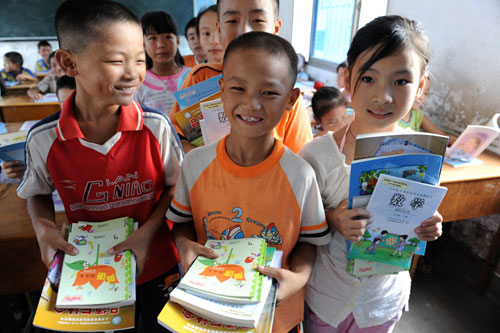Chinese families across the country are able to send their children to school tuition-free in the nine-year compulsory education period as of Monday.
From this fall semester, about 28.21 million urban students in primary schools and in junior high schools joined rural students to benefit from the plan, according to the Ministry of Education. The students still must pay for textbooks and uniforms.
 |
|
Deng Wenjun (middle) receives his textbook free of charge with his classmates studying in the Second Primary School in Zhangshu City of south China's Jiangxi Province on September 1, 2008. [Xinhua] |
Students in rural areas have already started to enjoy the treatment, benefiting about 150 million students.
The fees are not much for ordinary urban families but still a burden for low-income families like Liu Yang's.
The 12-year-old boy is in the sixth grade, the last year of primary school, in central Hunan's provincial capital Changsha. His father is sick and his mother is a domestic helper.
"I paid about 300 yuan, including fees for textbooks and uniforms, every semester in the first three years. In the past two years, the school exempted me from some fees," he said. "This semester, tuition and incidental expenses were exempted. The school did not charge me for textbooks or uniforms, either."
Other policies are helping children like him get an education.
Zhao Linxi, an 11-year-old girl in west Beijing, has received subsidies of 400 yuan from the school and 600 yuan from the government annually for three years.
"We are having some financial problems but I feel no burden to send my child to school," said Zhao's father, who has a spleen disorder that keeps him from working. The family depends on her mother's income.
"We are working on a comprehensive system to help children from poor families, including subsidies, scholarships and other preferential policies," said Cheng Binquan, an official with the civil affairs department of the Xicheng district government in Beijing.
(Xinhua News Agency September 2, 2008)